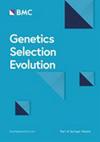The black honey bee genome: insights on specific structural elements and a first step towards pangenomes
IF 3.1
1区 农林科学
Q1 AGRICULTURE, DAIRY & ANIMAL SCIENCE
引用次数: 0
Abstract
The honey bee reference genome, HAv3.1, was produced from a commercial line sample that was thought to have a largely dominant Apis mellifera ligustica genetic background. Apis mellifera mellifera, often referred to as the black bee, has a separate evolutionary history and is the original type in western and northern Europe. Growing interest in this subspecies for conservation and non-professional apicultural practices, together with the necessity of deciphering genome backgrounds in hybrids, triggered the necessity for a specific genome assembly. Moreover, having several high-quality genomes is becoming key for taking structural variations into account in pangenome analyses. Pacific Bioscience technology long reads were produced from a single haploid black bee drone. Scaffolding contigs into chromosomes was done using a high-density genetic map. This allowed for re-estimation of the recombination rate, which was over-estimated in some previous studies due to mis-assemblies, which resulted in spurious inversions in the older reference genomes. The sequence continuity obtained was very high and the only limit towards continuous chromosome-wide sequences seemed to be due to tandem repeat arrays that were usually longer than 10 kb and that belonged to two main families, the 371 and 91 bp repeats, causing problems in the assembly process due to high internal sequence similarity. Our assembly was used together with the reference genome to genotype two structural variants by a pangenome graph approach with Graphtyper2. Genotypes obtained were either correct or missing, when compared to an approach based on sequencing depth analysis, and genotyping rates were 89 and 76% for the two variants. Our new assembly for the Apis mellifera mellifera honey bee subspecies demonstrates the utility of multiple high-quality genomes for the genotyping of structural variants, with a test case on two insertions and deletions. It will therefore be an invaluable resource for future studies, for instance by including structural variants in GWAS. Having used a single haploid drone for sequencing allowed a refined analysis of very large tandem repeat arrays, raising the question of their function in the genome. High quality genome assemblies for multiple subspecies such as presented here, are crucial for emerging projects using pangenomes.黑蜜蜂基因组:对特定结构元素的认识和向庞基因组迈出的第一步
蜜蜂参考基因组HAv3.1是由一个商业品系样本产生的,该品系样本被认为主要具有Apis mellifera ligustica的显性遗传背景。Apis mellifera mellifera 通常被称为黑蜂,具有独立的进化历史,是西欧和北欧的原始蜂种。人们对这一亚种的保护和非专业养蜂实践的兴趣与日俱增,加上破译杂交种基因组背景的必要性,促使人们必须进行特定的基因组组装。此外,拥有多个高质量基因组已成为在庞基因组分析中考虑结构变异的关键。太平洋生物科学技术公司从单倍体黑蜂无人蜂中获得了长读数。利用高密度遗传图谱将等位基因拼接成染色体。这样就可以重新估计重组率,在以前的一些研究中,重组率被高估,原因是错误的组装导致了旧参考基因组中的假倒位。获得的序列连续性非常高,连续的全染色体序列的唯一限制似乎是串联重复序列,这些序列通常长于 10 kb,属于两个主要家族,即 371 和 91 bp 重复序列,由于内部序列高度相似,在组装过程中造成了问题。通过使用 Graphtyper2 的庞基因组图谱方法,我们将组装结果与参考基因组一起用于对两个结构变异体进行基因分型。与基于测序深度分析的方法相比,获得的基因型要么正确要么缺失,两个变体的基因分型率分别为 89% 和 76%。我们为蜜蜂亚种Apis mellifera mellifera所做的新组装证明了多个高质量基因组对结构变异基因分型的实用性,并对两个插入和缺失进行了测试。因此,它将成为未来研究的宝贵资源,例如将结构变异纳入全球基因组分析中。使用单倍体无人机进行测序后,可以对超大串联重复阵列进行精细分析,从而提出它们在基因组中的功能问题。高质量的多亚种基因组组装(如本文所展示的)对于使用鲮鱼基因组的新兴项目至关重要。
本文章由计算机程序翻译,如有差异,请以英文原文为准。
求助全文
约1分钟内获得全文
求助全文
来源期刊

Genetics Selection Evolution
生物-奶制品与动物科学
CiteScore
6.50
自引率
9.80%
发文量
74
审稿时长
1 months
期刊介绍:
Genetics Selection Evolution invites basic, applied and methodological content that will aid the current understanding and the utilization of genetic variability in domestic animal species. Although the focus is on domestic animal species, research on other species is invited if it contributes to the understanding of the use of genetic variability in domestic animals. Genetics Selection Evolution publishes results from all levels of study, from the gene to the quantitative trait, from the individual to the population, the breed or the species. Contributions concerning both the biological approach, from molecular genetics to quantitative genetics, as well as the mathematical approach, from population genetics to statistics, are welcome. Specific areas of interest include but are not limited to: gene and QTL identification, mapping and characterization, analysis of new phenotypes, high-throughput SNP data analysis, functional genomics, cytogenetics, genetic diversity of populations and breeds, genetic evaluation, applied and experimental selection, genomic selection, selection efficiency, and statistical methodology for the genetic analysis of phenotypes with quantitative and mixed inheritance.
 求助内容:
求助内容: 应助结果提醒方式:
应助结果提醒方式:


